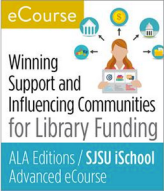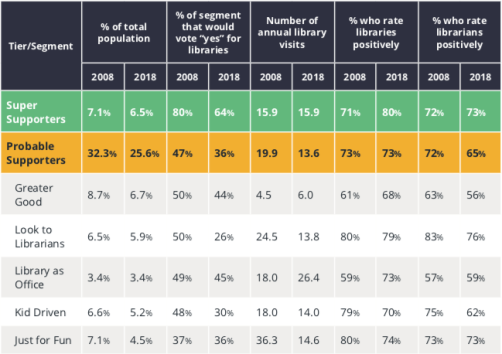OCLC recently released the latest data about voter support for libraries and the results should scare our entire industry out of political and advocacy complacency and away from the poor advocacy culture of storytelling that permeates our field. The results of the data have validated the fears of those of us at EveryLibrary and they’ve shown that we need to learn from some of the more politically savy and powerful organizations in the United States if we want library to continue to have the funding they need to remain into the future.
This report comes ten years after the previous “Awareness to Funding” study that was released in 2008 and underwritten by OCLC and the Gates Foundation. The original study looked at the awareness, attitudes, and underlying motivations among US voters for supporting library funding. This study was significant because it was the first time that anyone had looked at voter attitudes about library funding. The mere fact that it was a first of a kind study should worry us considering that more than 90% of library funding comes from the will of the local voter and the will of the local politicians. If we are concerned about library funding in the United States, the first place we should look is to the voters and politicians who are responsible for funding us.

The results of the original study did a lot to dispel a number of myths about why Americans are willing to vote to tax themselves to support libraries and indicated largely positively voter and political support for libraries. For example, they found that 37% of voters were almost definitely going to vote yes for libraries and another 37% of voters were likely to vote yes for libraries. That left only 26% of voters who most likely would vote no for a library funding initiative. The study found that library users were not necessarily more likely to vote yes for library funding measures and in fact, non-users were just as likely as non-users to vote for libraries. It also found that political support for libraries was not dependent on political party or affiliation. Instead it found that the most influential variable in voter support for libraries was the relationship and trust in the librarians themselves.
Through this study we learned that we need better data to understand who our most likely supporters might be or to more efficiently run library campaigns by more easily identifying likely voters and likely non-voters. It became apparent that our lack of data meant that we have no way to use enhanced voter files to reduce the number of voter contacts and voter contacts are one of the most resource heavy aspects of a campaign. For example, if we could determine the profile of a library voter, we could use that data against an enhanced voter file to significantly lower the cost of campaigns and drastically increase the success rate of library campaigns allowing us to better fund our libraries. This profile is typically called “model voter data” and the fact that the study did not help us determine model voter profiles was one of the biggest flaws in the study.
The difference between support and voting
One of the most important underlying issues is that there is a remarkable difference between being in favor of libraries and having a willingness to vote in favor of taxation. This distinction was realized in the results of both studies and this distinction needs to be understood if we want to influence elections for libraries. The most disturbing trend that was identified in the 2018 study was that favorability for the services and programs of libraries has increased among our strongest supporters and remained steady for probable supporters but willingness to vote or pay more in taxes to supply those services and programs have declined a significant amount. In fact, the willingness to vote yes for libraries has declined by more than 10 percentage points across the country.

What this means is that many of our current advocacy models are working if our measurement of advocacy is overall opinion of libraries. But, that overall opinion will not lead to more votes or political support and because funding is directly affected by those two factors these results do not bode well for future funding initiatives. That means that without the political will, there is no funding, and therefore, there are no libraries. Most importantly, it shows that our advocacy measurements for success are wildly ineffectual and misguided if we want libraries to exist for future generations.
I would argue that not only are our measurements wrong, but our entire advocacy ecosystem needs to be re-imagined. Our industry largely relies on the idea that if we tell good stories that people will stand up and take action on our behalf. This misguided ideology leaves most of the actual work of true advocacy on the table. In fact, while most of the recommendations from this study are fairly routine and primarily surround issues of voter education, the study points to two recommendations that I believe that we need to take seriously. Those are:
Target public awareness efforts
Awareness of library offerings and value continues to be a challenge—perhaps one that is only growing as people are more distracted and diverted into a fragmented communications environment. The Pew Research Center has consistently found in their household surveys that many Americans, including library users, are still unaware of the breadth of resources offered by the public library. The market segments and their characteristics outlined in the original research and updated here can better enable library professionals to target communications and customize messaging via traditional and social media channels to more effectively reach people. For instance, libraries may connect announcements of new programs or services to larger stories about how the library supports school-age children, workforce readiness, or small business development.
Cultivate and Empower Super Supporters
A significant bright spot in the research is that support among library Super Supporters—a small but mighty group—is largely unchanged. This segment’s loyalty should not be taken for granted, but rather nurtured and protected. In addition, library leaders can consider how to engage and leverage this group as library ambassadors to advocate with decision makers and influence other segments of the population that might be more disconnected or skeptical.
For the last 5 years, libraries not sufficiently addressing these two issues has haunted our work at EveryLibrary.
The first, “Target public awareness efforts,” points to the fact that a number of organizations that claim competency in Marketing in our industry are most often confusing marketing and advertising. Advertising comprises the tactics used to put messages into the community such as radio, tv, billboards, bar coasters, and other tchotchkes and giveaways. ALA’s own Libraries Transform and OCLC’s Geek the Library are both examples of this. Both of these campaigns are simply advertising and promoting libraries in general libraries. But true marketing encompasses a more holistic approach to getting the word out and measuring real results against goals. It includes real data driven and measureable activities. As written in “Investopedia; “The essential strategic components of a marketing effort are commonly called the four Ps: product, placement, promotion and price. Advertising, which is how a company communicates to prospective clients about the product or service, falls under the category of promotion.” And promotion is really the focus of most of the activities that our industry calls marketing.
Of course, there’s nothing wrong with advertising our libraries. We should be doing everything we can to promote them. And, again, the advertising is “working” if our measurement of working is that people view libraries more favorably. It’s just failing if our measurement is that people are willing to pay the price for libraries through taxes and under any definition of the word, this more important measurement comes from true marketing.
And, of course, this typically isn’t the fault of the library staff. Libraries often do such a poor job marketing themselves that any kind of advertising or promotional activity is an improvement and will return some kind of result and lead library staff to falsely believe that they are great at marketing, go on and present at conferences, write books and articles, and continue the narrative in our profession that advertising is marketing.

Addressing this issue would take more time, energy, and space, than I’m willing to delve into in this blog post. However, I highly recommend looking outside of the library industry for guidance on understanding true marketing. Of course, I would also recommend my eCourse with ALA Editions where we dive deep into data driven and measureable results through proper communications and customer relations. But again, this is all taken from outside of the library industry.
The second issue, “Cultivate and Empower Super Supporters,” is exactly how political power is built and used although I would argue that it should read “Identify, Cultivate, and Empower Support Supporters.” This is advocacy beyond storytelling and requires significant time and energy on the part of the organizer and might better be described as activism. Notice also that there is nothing here to indicate a need for users. The word “supporters” in this recommendation is both important and intentional. The data from this report reinforce the argument that we have been making at EveryLibrary and that OCLC is making here, that library use does not at all equal to or correlate with library support. In fact, while we are running library campaigns, we see in poll after poll that library users are not more likely to vote yes or no for a ballot initiative or take action for libraries than non-users. As this study also showed, we have no real meaningful data point to use to identify which community members are likely to support libraries and which aren’t. This leads us to the difficulty of identifying library supporters in the community and if we can’t identify them then we can’t cultivate them, and if we can’t cultivate them then we can’t empower them.
That’s why one of the largest projects of EveryLibrary is identifying the people across the country who support libraries. We do this through a wide range of tactics. The most visible tactic is our use of Facebook and our one million Americans for libraries campaign. While this is only one of many tactics that we use, it is one that most people can quickly and easily understand and see in action. By taking the time to identify library supporters (or rather, allowing them to self-identify by liking our page) we are able to look at the data about who supports libraries through Facebook’s Audience Insights platform and then cultivate their support through targeting ads and messaging that tie libraries to the issues that they care about. This one tactic alone has been so effective that we regularly are able cultivate our followers and empower them to take action to support libraries that far exceed and return our expenses. For example, we were able to raise $6 for every dollar we spent in the few days after Trump announced his cuts to Federal Funding for libraries. We were also able to activate supporters into action for a few pennies per action. We were then able to use these donations for more expensive tactics later in the campaign when engagement significantly dropped and costs per action drastically increased as naturally happens with any social media activism activity. We were also able to capitalize on the thousands of early supporters by empowering them to continue to take actions on behalf of IMLS.
If we can continue this trend with an even larger audience of identified super supporters then we can empower these supporters to take larger actions for libraries and exercise real political power and pressure on our nation’s leaders. If we were able to reach one million self-identified supporters (as likes on Facebook, for example), then we could spend resources cultivating those individuals to become more entrenched super supporters who are more willing and likely to take action. That would mean that anytime there was a threat to libraries, we would be able to reach millions of like-minded Americans each week and encourage hundreds of thousands of them to take action such as signing petitions, contacting representatives, attending rallies, and making donations.
If we’re being honest, this isn’t a new or interesting concept. It is no different than tactics generally used by any large cause, candidate, or political organization. Using the NRA as an example, the reason that we are not able to pass gun laws in the United States is not because the majority of Americans are against gun restrictions but it is because there is a very radicalized minority of identified, cultivated, and empowered supporters who are very vocal and will take action through the drop of a single email or post on Facebook. There is no reason that we can’t do the same for education and libraries in this country and drive the legislative and policy changes we need to support our organizations. But this i
s only done through a very long and methodological process of identification, cultivation, and empowerment beyond storytelling and beyond simply using Facebook or putting up some billboards.

Again, this blog post is too short to detail this process. But, if you’re interested in learning, I have spent the last five years working with some of the best presidential campaigners, community organizers, and cause related organizations. I’m excited to bring back everything I’ve learned to libraries through my eCourse with ALA Editions. In this course I teach the basic theories and concepts that can be applied at libraries of any budget level or serving any community size. This process will also be detailed in our upcoming book from ALA Editions (title still under consideration) but we touch on it in Winning Elections and Influencing Politicians for Library Funding.


